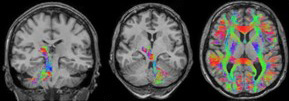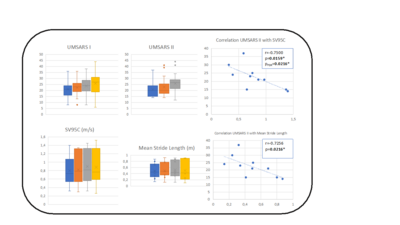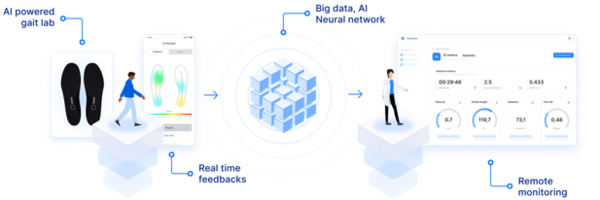Item 4 - Axial symptoms as a biomarker of neurodegenerative diseases: multimodal approach and usefulness of connected devices
Walking is a crucial biomarker for health, and decreased walking speed is correlated with life expectancy (Middelton et al., 2014. Walking speed: the 6th functional vital sign)
In neurodegenerative diseases affecting the basal ganglia (BG); namely Parkinson's disease (PD) and parkinsonism, walking is very quickly affected, and monitoring the evolution of the deterioration of gait parameters is crucial to determine (i) the prognosis of the disease (falls and cognitive deterioration) (ii) therapies (pharmacological and non-pharmacological). Due to the increase in the number of patients and the need for early intervention, self-rehabilitation is a solution to delay axial symptoms (Gilat et al., 2023)
Home gait monitoring using connected devices in Parkinson's disease (Gait N Park study/ClinicalTrials.gov identifier: NCT04653688)
We prospectively recruited 80 PD patients at different stages of the disease and 25 early MSAs, and performed repeated multimodal assessments (clinical, supervised gait assessment with connected insoles, unsupervised assessments with connected insoles, 3TMRI, blood neurofilaments, genetics, etc. .) in order to 1°) Improve early diagnosis between Parkinson's disease and other syndromes (MSA); 2°) Improve the prognosis of walking in relation to the evolution of the disease (Marchand et al., in prep., figure 1)
We therefore used multimodal biomarkers including gait and imaging with a prospective and longitudinal evaluation in PD and SMA: (i) 3T MRI showed significant changes: an increase in cerebellar WM was observed at S48 relative to baseline as well as in the putaminal DM (Figure 2). Concerning tractographic analysis, significant increase in MD values of SN-DN tract and DN-Thalamus (Marchand et al. in prep.) Different profiles between PD and MSA and subtypes of MSA.
Gait monitoring as part of free-living assessment in PD is a major unmet need!
There is evidence of high sensitivity to change during free-living assessment, gait parameters are more impaired than in the laboratory, and longer periods of time are more discriminative for gait-specific gait impairments. MP. Measured real-life walking may therefore be a more sensitive surrogate marker of PD. pathology than laboratory measurements and superior in assessing disease characteristics such as risk of falls and freezing of gait.
Promoting the self-rehabilitation of Parkinson’s patients using technology (FeetMe HEALTH® connected insoles)
We are conducting a French randomized, controlled, multicenter study followed by an open extension to evaluate the effectiveness of the FeetMe® home rehabilitation program compared to conventional physiotherapy in patients with Parkinson's disease using connected insoles.




